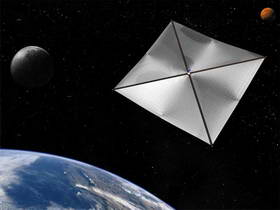Although the chances of an asteroid hitting Earth appear to be small for any given year, the consequences of such an event would be monumental. The science community has come up with some ideas and proposals for ways to mitigate the threat of an incoming asteroid hitting the Earth. Some proposals suggest almost Hollywood type theatrics of launching nuclear weapons to destroy the asteroid, or slamming a spacecraft into a Near Earth Object to blow it apart. But other ideas employ more simple and elegant propositions to merely alter the trajectory of the space rock. One such plan uses a two-piece solar sail called a solar photon thruster that draws on solar energy and resources from the asteroid itself.
Physicist Gregory Matloff has been working with NASA’s Marshall Spaceflight Center to study the two-sail solar photon thruster which uses concentrated solar energy. One of the sails, a large parabolic collector sail would constantly face the sun and direct reflected sunlight onto a smaller, moveable second thruster sail that would beam concentrated sunlight against the surface of an asteroid. In theory, the beam would vaporize an area on the surface to create a ‘jet’ of materials that would serve as a propulsion system to alter the trajectory of the Near Earth Object (NEO.)
Changing the trajectory of a NEO exploits the fact that both the Earth and the impactor are in orbit. An impact occurs when both reach the same point in space at the same time. Since the Earth is approximately 12,750 km in diameter and moves at about 30 km per second in its orbit, it travels a distance of one planetary diameter in about seven minutes. The course of the object would be altered, or either delayed or advanced and cause it to miss the Earth.
But of course, the arrival time of the impactor must be known very accurately in order to forecast the impact at all, and to determine how to affect its velocity.
Additionally, the solar photon thruster’s performance would vary depending on the unique makeup of each NEO. For example, asteroids with a greater density, radius or rate of rotation would cause decreased performance of the solar photon thruster in acceleration and deflection.
Even though the solar photon thruster appears to be efficient in its performance, Matloff said that more than half of the solar energy delivered to the “hotspot” on the NEO would not be available to vaporize and accelerate the jet due to other thermodynamic processes such as conduction, convection, and radiation. As expected, a larger collector sail radius would increase the amount of energy available, and would increase acceleration of the NEO. Matloff said this system allows the sail craft to “tack” against the solar-photon breeze at a larger angle than conventional single solar sails can achieve.
This system of sails would not be attached to the NEO, but would be kept nearby the NEO “on station” either with its own thrusting capability or by auxiliary electric propulsion. More studies would be needed to ascertain if a supplementary propulsion system would be necessary.
The sails used in the study were both inflatable. However, Matloff believes it might be worth considering a small rigid thruster sail, which might simplify deployment and reduce occultation.
Said Matloff, “Hopefully, future design studies will resolve these uncertainties before application of NEO-diversion technology becomes necessary.”


All of this is simply speculation and imagination if the NEO Preparedness Act (H.R.4917) is not passed in congress. Read the whole text of the bill using the library of current legislation at the Political Action for Space website.
Then contact your congressmen from your state using the tools at Political Action for Space. and tell them that they are irresponsibly denying protection from a likely catastrophe waiting to happen.